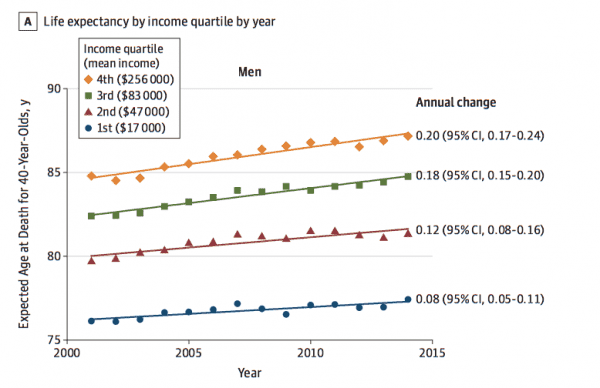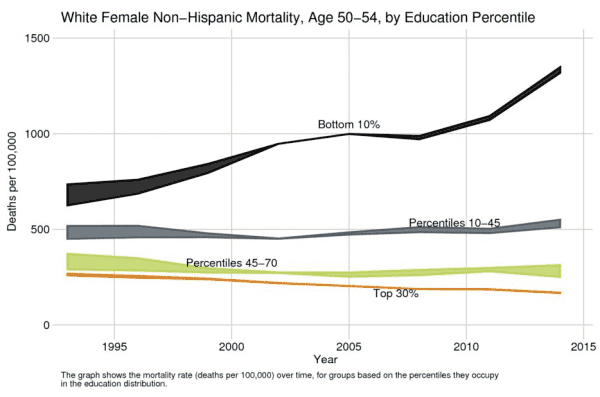
Living in the US increasingly looks like a health risk. Average life expectancy in the country dropped for the third year in a row, according to recent data from the Centers for Disease Control and Prevention. That’s the longest downturn since the Spanish flu wiped out more than 50 million people a century ago.
The grim trend stems from a toxic mixture of more drug- and alcohol-related deaths and more suicide in many parts of the country. And it puts Americans at a higher risk of early death compared to their counterparts in other wealthy countries.
Related
Drug overdose deaths were so bad in 2017, they reduced overall life expectancy
But what’s often lost in the conversation about the uptick in mortality in the US is that this trend isn’t affecting all Americans. In fact, there’s one group in the US that’s actually doing better than ever: the rich. While poor and middle-class Americans are dying earlier, the wealthiest among us are enjoying unprecedented longevity.
So when we talk about life expectancy slipping, what we should also talk about is the growing problem of health inequality in America. And it’s an increasingly urgent discussion, health researchers are warning, because of policy changes on the horizon that are poised to make the mortality gap even wider.
Some of these policies will hamper access to medical care (such as rescinding funding for CHIP, the health insurance program for low-income children) but others that aren’t even directly related to health care, like tax cuts, may have even more insidious effects on the American mortality gap.
America’s alarming life expectancy gap
The rich have long-enjoyed more longevity than the poor, but the gap in life expectancy has been widening in the US over the past few decades, along with other types of social and income inequality.
The CDC’s Division of Vital Statistics, which tracks mortality in the US, uses death certificates as the data source and doesn’t collect family income data. But we do have good data on the mortality gap and income from a study published in JAMA in 2016.
A group of researchers, led by Stanford University economist Raj Chetty, analyzed income data for the US population from 1.4 billion tax records between 1999 and 2014. They then compared it with mortality data from Social Security Administration death records. They found that, from 2001 to 2014, the richest Americans gained about five years of longevity, while life expectancy for the poor didn’t budge:

They also found that men who were among the top 1 percent of income earners lived 15 years longer than men at the bottom 1 percent. For women at the extremes of the income distribution, life expectancy differed by 10 years. At Vox, we broke their data down by state, and you can see that wealthier Americans are living longer than poorer Americans all across the country. (Here’s the data on men, but the same trends hold for women.)

An October 2018 working paper out of Dartmouth College sliced the mortality data along lines of education and found a similar trend. Researchers looked at the rising mortality among middle-aged, non-Hispanic whites by education status. The rise, they discovered, is almost entirely driven by the least-educated 10 percent of the population, while the most educated among us are seeing their mortality rates go down:

“Like the poor, the least educated experience a range of socioeconomic disadvantages,” the researchers, Paul Novosad and Charlie Rafkin, wrote, “such as high unemployment, low insurance coverage, poor nutrition, and exposure to harmful environmental factors.”
But this life expectancy divide between the haves and have-nots isn’t entirely new: It has been growing for decades in America. A report from the National Academies of Science looked at life expectancy by income groups between 1980 and 2010. In 1980, the richest cohort of middle-aged American men could expect to live until about 83 and the poorest to 76. By 2010, the richest American males had gained six years in life expectancy, living to 89 on average, while life expectancy for the poorest men hadn’t improved. (The Washington Post has nice visualizations of the data in the report here.)
“Because we have widening income inequality and there’s a bigger gap between haves and have-nots … we are seeing a bigger divide in mortality,” Steven Woolf, a researcher at Virginia Commonwealth University who has been researching income and mortality, told Vox in January.
Tax reform and other Trump-era policies are expected to make the gap worse
This growing gap should be “a dramatic reminder of what actually affects our health,” Woolf added.
We often think about health status in terms of access to doctors, hospitals, and medicines. But access to health care only accounts for about 10 to 20 percent of our health outcomes. Far more influential on our health is our socioeconomic status and certain health behaviors, like smoking, eating healthfully, and getting exercise.
In Chetty’s study, for example, the researchers found that life expectancy among the poorest individuals was “significantly correlated” with health behaviors like smoking, obesity, and exercise. Poorer people are more likely to be overweight, smoke, and drink compared to their wealthier counterparts. Interestingly, these effects seemed to be mitigated in places that had enacted policies to curb poor health behaviors — such as anti-smoking laws or trans fat bans in cities.
Right now, there are several policies that are not only expected to hamper health care access but also exacerbate income inequality — and widen the life expectancy disparity, David Blumenthal, president of the Commonwealth Fund, says. Blumenthal has written about the potential effects of the tax bill President Donald Trump signed into law last December, on low- and middle-income Americans in particular, and how it’ll disproportionately ding them while rich Americans and corporations will enjoy tax breaks:
Blumenthal told Vox in January, “We can expect … to see the gap in life expectancy and health care outcomes between low- and high-income Americans grow in coming years if gaps in income increase.”
Vox’s Dylan Scott and Alvin Chang have also argued that the tax bill — because of its tax breaks for the rich — “takes the wheel of America’s already-dramatic income inequality and presses the accelerator.” That’s not to mention Congress’s failure to fund CHIP, the growing number of uninsured children in the US, and the new work requirements that have thrown people off Medicaid, the government health insurance program for low-income American.
So instead of just focusing on the overall decline in life expectancy, we need to start talking about these links between policy and worsening income inequality, and its relationship to the growing mortality gap. If we don’t, Woolf warned, we’ll fail to see the solutions to America’s early death problem.
Sourse: vox.com






